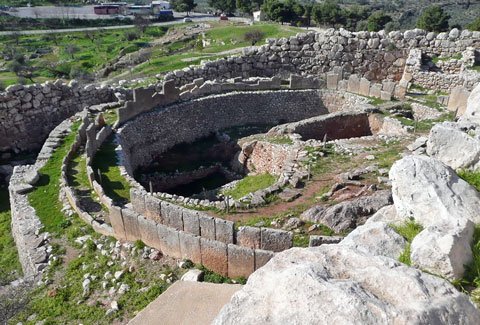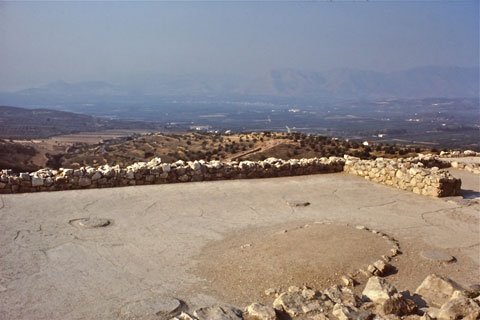Although there are other sights to view in this area, the Mycenae citadel is the main attraction. From a distance it look no different from other hills of Argos, and you may wonder if the walk up from the car park is worth it.
As you begin your stroll up the path, remember that this citadel dates from the 16 to 12 C BC. It was from this citadel that king Agamemnon led the Greeks when they sailed off to fight the Trojans as described in the epic poem by Homer known as ‘The Iliad’ and, of course, “The Odyssey”.
The Lion Gate
As you approach the entrance, you’ll notice the large stones of which the walls are made. These were often referred to as ‘Cyclopean’ fortifications, named after the giant Cyclops who were supposed to have built them.
The path leads you up between the walls, and in front of you is the famous Lion Gate. The massive stones of this celebrated entrance contain the reliefs of two lions. Unfortunately the heads are missing, but the entrance is still very imposing. The pediment is monolithic, meaning it is composed of a single large stone.

More photos from our 2019 visit
The animals are situated either side of a central column, with their paws resting on a double altar. It is thought that the scene was influenced by Asiatic ideas. As with much architecture (especially that of a state) the entrance was designed to impress those entering the Mycenae citadel with the power and authority of this important centre.

First circle of royal tombs
As you pass through the Lion Gate into the Mycenae citadel, you’ll see on your right the famous cemetery discovered by Heinrich Schliemann in the 1870’s. Schliemann believed Agamemnon was buried here, but the grave site is much older, dating from the 16 C BC.
The graves contained the bodies of 8 men, 9 women and 2 children. Many burial furnishings and artifacts were also found, and they are some of the most beautiful ancient objects ever found. They are now on display in the National Museum in Athens.
Beyond the grave circle more excavations are being made, and from time to time new structures are revealed.

The Palace
Now make your way up the path to the Palace. The path takes you straight to the Palace, which misses the site of the propylaia, or palace entrance. This opened onto the great courtyard, which was an uncovered area.
The courtyard leads into the area of most interest which is the ‘Megaron’. This was the central royal chamber with a round hearth in the centre, and four pillars supporting the roof. You can still see the bases which supported the pillars. The floor was paved with gypsum, and the walls would have been faced with stucco and painted in the Cretan style using decorative motifs.
The Eastern section
The eastern part of the Mycenae citadel is worth exploring. Here you’ll find fortification dating from the 12 C BC.
You’ll find a postern at the far end, from which there are very good views of the ramparts. To the left is an entrance to an underground staircase. There are 99 stairs, and they lead to a secret cistern.
A short distance west takes you to the North Gate. If you go outside you’ll see the approach is protected by a section of the wall which juts out, which was designed to favour defenders over attackers. From outside you can get a good view of the impressive rampart walls.
Don’t forget the tombs
When you leave the citadel, don’t forget to take a look at the tombs to the west. Then go down the road to see the best preserved Treasury of Atreus, or Tomb of Agamemnon (both names for reference only – no one really knows who it belonged to).

You can also walk through the citadel and museum with us in 2019 Mycenae Citadel